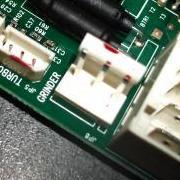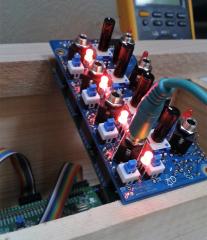-
Posts
311 -
Joined
-
Last visited
-
Days Won
8
Content Type
Profiles
Forums
Blogs
Gallery
Everything posted by Psykhaze
-
So if it's MIDI only , how do expect to manage waveforms on OLEDs? If not generated in MBHP context, how do you plan to capture/generate waveforms?
-
Ok . So you will use an AOUT module/ I2S DAC for DCO etc ? How will you generate audio output? Where will be the 40x2 display? I get the thing about the OLED stuff but could you extend a bit your drawing to the total interface? Maybe MB-CV V2 project may contain much that you can expect instead of MB-NG , if your goal is managing Digitally Generated Audio ? Bests , Jerome
-
HD44780 is a generic character display controller . SSD1306 is an OLED controller . They are not the same and are not controlled / plugged the same way. Why do you want to do the conversion? It's hard for me to get what you want to do with your displays. Maybe try to make a draw of the interface you are expecting in the end. It would help me to understand at least. Bests, Jerome
-
Your intial question is somewhat blurry and hard to answer. Your MIDI Keyboard is not especially common and MIDI Bindings for managing your SID parameters is a bit up to you. When you talk about "optimal" setup, it's also related on how you play and features you use, i mean there is no specific answer to this. You ask for a MIDI "optimal" binding and mention controls on your keyboard and a SID synth. Which SID synth is it ? MB-6582 / Sammich ? Can you map CC standalone or need a computer driver? No need to be angry ,just try to provide more information and be more precise in your question =) Bests, Jerome
-
Pretty nice job! Very Abstract Concept that may find a lot of possible practical uses. (Who said Modulbox-ng?) Design very compact and chainable , and SMT pitch sounds accessible to hand soldering. Maybe surface mount transition for MBHP has already started ^^? What's about the BOM? i guess some 74HC*** but i wonder about capacitors/resistors when i see footprints? also SMT? Good to see you managed to deal with HSV<>RGB conversion (wrote any conversion function? how did you passed H+V values in the end?). Good to hear about the voice comment too, helps a lot. About taste, I especially love OLED 45° integration . One last question,at your advice would the encoder brightness be enough for daylight playin ? Once again, pretty impressive! Bests, Jerome
-
I love the message on the OLED - that's 2min i'm out of laughing xD
-
Thanks for the precision @Zam i did not even noticed and forgot to tell about the discovery board =) Sharp eye ! Also the thing with SmashTV is to keep patience,he always end in sending you the stuff but sometimes restocking from his side might take a while, that is not an easy thing to supply a community. But he almost provides kits or at least boards for all mentionned modules if you wait a bit . Or you might have fun following UCapps schematics and remake PCBs for your own entertainement (starting with DIN / DOUT modules could be an idea before the motorfader module) BOM are detailed on the wiki with corresponding mouser refs as a start. I advice anyway to begin with smashTV kits. Hope to not overwhelm you, Bests, JK
-
Yea i like the idea of motorfaders salvaged . Good job ! I just hope there will not be too much compatibility problem , but you will learn by hacking/trying too . And as i use to say there is no problems,only solutions =) Also good to see you are happy to learn , that kind of people becoming rare out there these times :) Enjoy each step after each other and build the project of your dream ! If any help needed you will find good advices from peoples out there on the forum also! Bests, JK
-
Cool to see you are not frightened ! This is the most important ! If you take the necessary time to read,understand,ask questions and not give up you can do almost anything =) I was talking about the MotorFader module you mention and yes you can chain 2 of them to have your 16 tracks . Buy link : http://midiboxshop.bigcartel.com/product/mf_ng-module-board My advice would be to buy first a STM32F4 core board http://midiboxshop.bigcartel.com/product/core-stm32f4-board and then try to link 1 or 2 MotorFaders modules to play with. But motorfaders are expensive,be warned . You can also start with DIN / DOUT modules ( http://midiboxshop.bigcartel.com/product/din-module-board / http://midiboxshop.bigcartel.com/product/dout-module-board ) to play with illuminated buttons. Would be cheaper . If you want to mess up with PCB design i advice you to go with KiCAD, even if few (none?) designs are available this format. Infos here: http://wiki.midibox.org/doku.php?id=kicad If any questions feel free to ask Bests, JK Edit : @Zam has much knowledge about the field of motorfaders. Maybe he is the most skilled to answer questions related to this.
-
AFAIK you told about almost all LED-rings boards that exists. You should ask @Phatline as i remember he has extra stock about led rings boards.About motorfaders i guess you've seen about MB-MF-NG. Illuminated Encoders from @latigid on might interest you too. Did you seen the MB-Programma also? For later interest here is a on-going project (prototyping stage) i work on : http://wiki.midibox.org/doku.php?id=mb-modulbox-ng. Bests, JK Edit : Also about DAW you should try Renoise, Interface sounds hardcore at first sight but after less than an hour of tutorial you can make the same than ableton and even better =)
-
sending 16 bits as 8bits H +8bits V concatenated and parse? idk if possible for real,just a naive guess.
-
Why do you absolutely want *.brd files ? What do you mean to do? that sounds a bit weird to me. Seems you did not looked the wiki or you would have found this for example : http://wiki.midibox.org/doku.php?id=mb-twinsid
-
Wow great Work @BEBDigitalAudio ! I will give it a deep review / test / I will try to make a similar Tutorial with Code:blocks . If you have no wiki account i will be pleased to create the following content, just pm me =) Bests, Jerome
-
Then to answer initial question : nice comparator : http://pcbshopper.com/ bookmark list: http://www.seeedstudio.com/ http://www.elecrow.com/ http://www.pcb-pool.com/ppfr/index.html http://www.pcbgogo.com/orderonline.aspx http://www.pcbcart.com/ http://www.custompcb.com/index.php http://www.eurocircuits.com Bests,Jerome
-
Thank you for bringing me out here @latigid on =) @Pingaaas : i'll start by bringing you to some wiki links you may find useful:: http://wiki.midibox.org/doku.php?id=eagle http://wiki.midibox.org/doku.php?id=kicad http://wiki.midibox.org/doku.php?id=etching_pcb Then as mentionned, Modulbox-ng project aims to be some "modular" to build-as-you-will MIDIbox Controller . We thought it compatible with Eurorack sizes and based upon the latest MB-NG features. But it's still in prototyping stage currently. Wiki page tells about current specifications . Maybe you are interested about bringing your reflexion / needs to the project. Also , If you have further interest in PCB crafting, i will soon test self etching methods and would be happy to exchange about that. Do not hesitate contacting me in PM =) Bests, Jerome
-
http://www.alps.com/products/e/category_potentiometer.html http://www.bourns.com/products/potentiometers
-
http://www.willzyx.com/collections/x0xb0x
-
-
-

New generation Pic32 Controllers from Microchip
Psykhaze replied to Psykhaze's topic in Parts Questions
thank you @lis0r for everything,that's already a lot =) I also have to make searchs by my side ! Bests, Jerome -

New generation Pic32 Controllers from Microchip
Psykhaze replied to Psykhaze's topic in Parts Questions
@lis0r Ok thanks . Now i've ordered the 64 pins version i think i will try to stick to it . I was thinking about "simple" high speed digital mux/ demux if you may advice me something ? What about aditionnal external memory ? Maybe sticking to 144 pins version? Thanks again for your answers :) Bests, Jerome -

New generation Pic32 Controllers from Microchip
Psykhaze replied to Psykhaze's topic in Parts Questions
@lis0r : I am also looking for newer replacement for 74HC165/74HC595 digital shift registers, eg something adapted to the PIC32 Bus bandwith / speed. Maybe some additionnal DMA memory chips too ? Maybe you have something to advice me or maybe a start point for some researchs ? Bests, Jerome -

New generation Pic32 Controllers from Microchip
Psykhaze replied to Psykhaze's topic in Parts Questions
Ok nice . I will give it a try for a new core/aout concepts, as well as i am going to receive some free samples of microcontrollers and D/A converters. Bests , Jerome -
Just ordered some free samples from Microchip , did anybody has ever gave a try to PIC32MZ2048 family ? Took 2 of these : http://www.microchip.com/wwwproducts/en/PIC32MZ2048EFH064 Features Sounds huge even if package TQFP and price sounds low (-9€/pc) General 252 MHz/330 DMIPS, MIPS Warrior M-class core DSP-enhanced core: Four 64-bit accumulators Single-cycle MAC, saturating and fractional math IEEE 754-compliant Dual Panel Flash for live update support FPU for fast single- and double-precision math 12-bit, 18 MSPS, 24-channel ADC module microMIPS mode for up to 35% code compression CAN, UART, I2C, PMP, SQI & Analog Comparators SPI/I2S interfaces for audio processing and playback Hi-Speed USB 2.0 Device/Host/OTG 10/100 Mbps Ethernet MAC with MII and RMII interface 50 MHz Serial Quad Interface (SQI) Peripheral Pin Select (PPS) functionality to enable function remap Peripherals: 8 channels of hardware programmable DMA and 18 channels of dedicated DMA with automatic data size detection Six UART modules (25 Mbps): Supports LIN 1.2 and IrDA protocols Two CAN modules 2.0B Active with DeviceNet addressing support Six 4-wire SPI modules (50 Mbps) SQI configurable as an additional SPI module (50 MHz) Five I2C modules (up to 1 Mbaud) with SMBus support Parallel Master Port (PMP) Hardware Real-Time Clock and Calendar (RTCC) Nine 16-bit Timers/Counters (four 16-bit pairs combine to create four 32-bit timers) Nine Capture inputs and Nine Compare/PWM outputs ADC / Audio: Onboard 12-bit ADC Module 24 inputs with integrated S&H Six digital comparators and six digital filters Audio data master clock: Fractional clock frequencies with USB synchronization Audio data communication: I2S, LJ, RJ, USB Audio data control interface: SPI and I2C™ Graphics interface: PMP Soft: MPLAB Harmony - PIC32 software development framework C/C++ compiler with native DSP/fractional and FPU support TCP/IP, USB, Graphics and mTouch middleware RTOS Kernels, Express Logic ThreadX, FreeRTOS, OPENRTOS, Micriµm, µC/OS and SEGGER embOS Bests, Jerome
-
L'after-touch c'est un peu le "plaquage" post-déclenchement, si tu reste appuyé sur une ou plusieurs touches et en fonction de la force avec laquelle tu maintien l'appui, ca va t'envoyer des informations post "toucher" de la touche . Ca permet d'avoir des accords modulés dans la longueur par exemple



